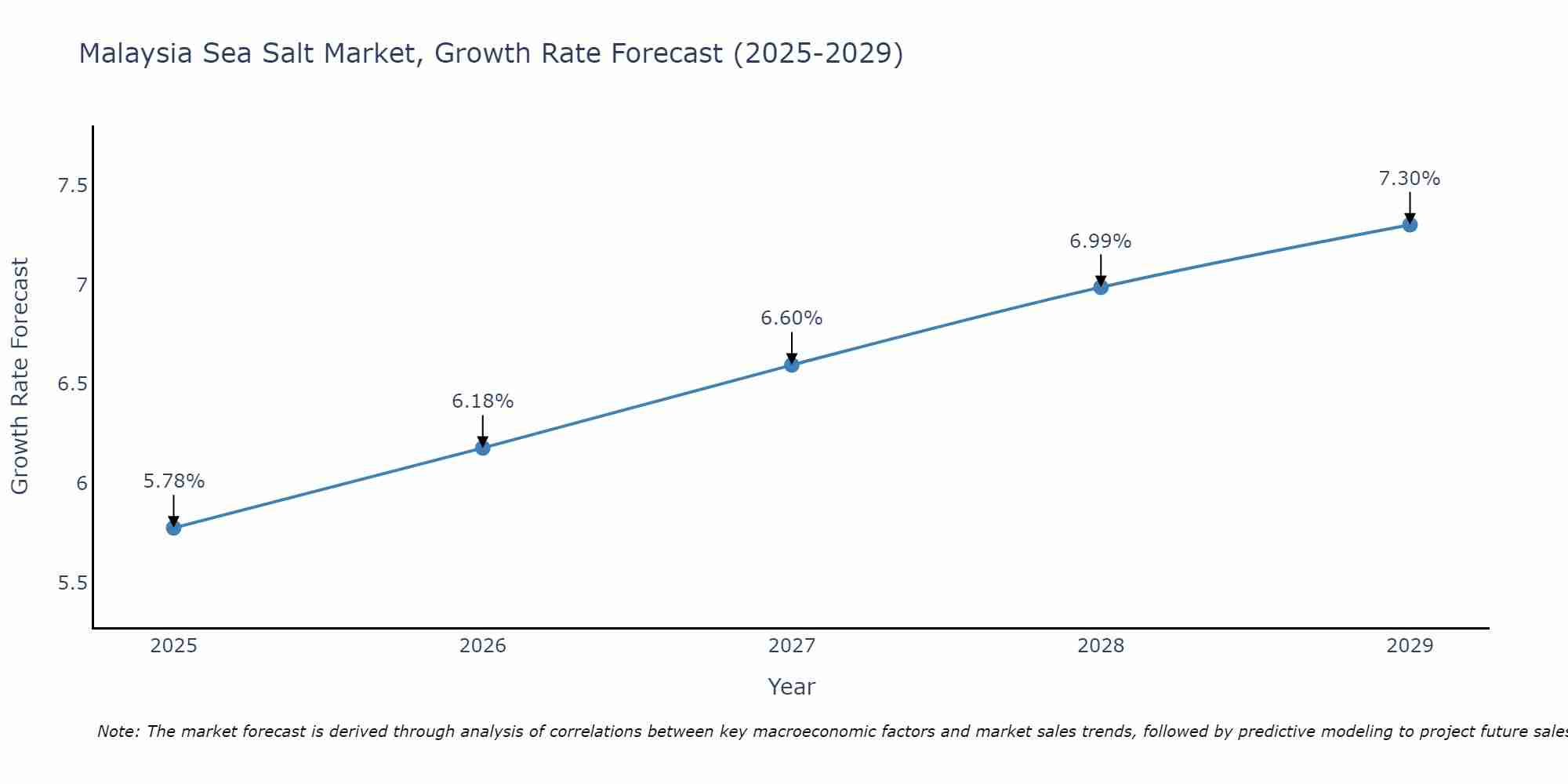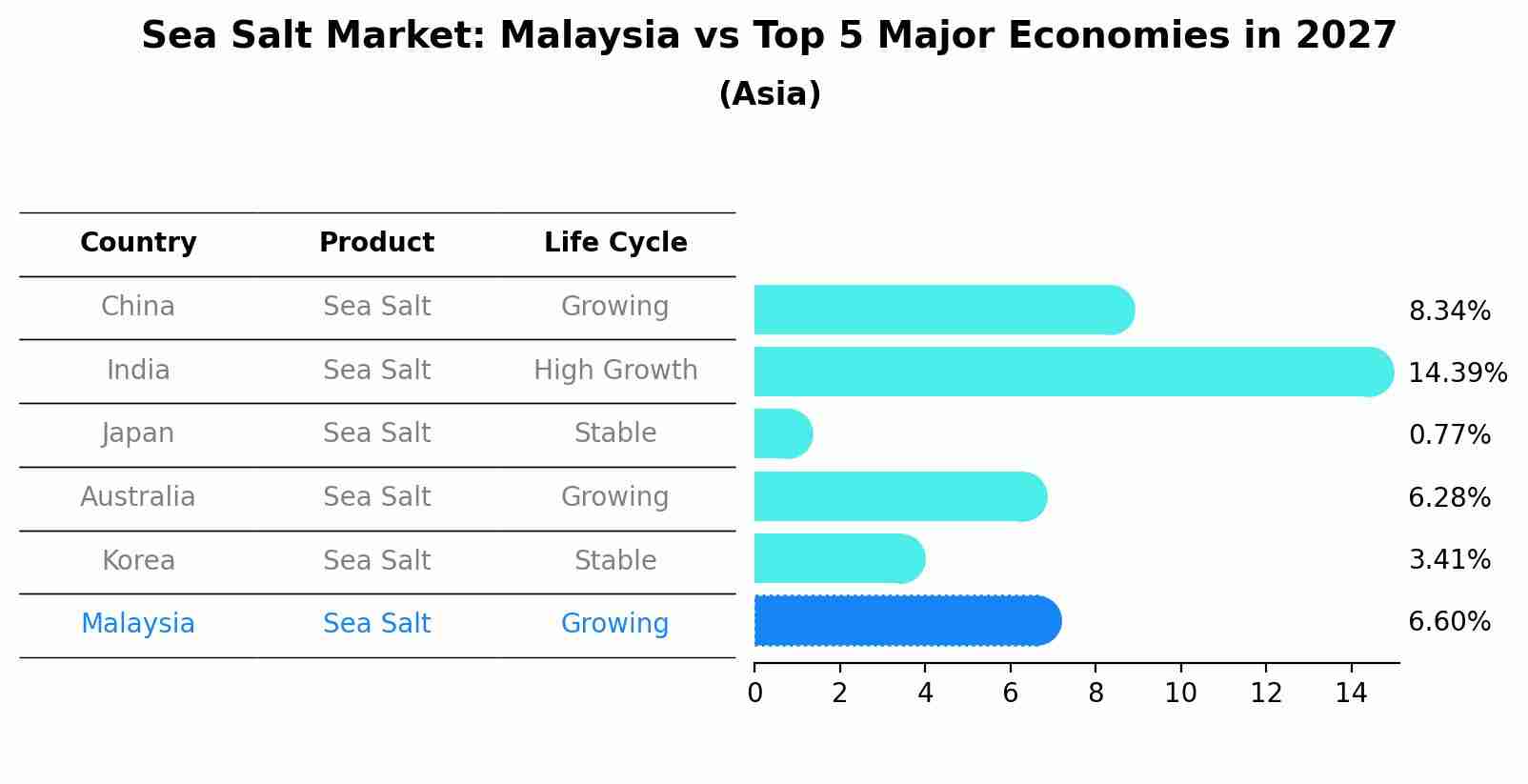Malaysia Sea Salt Market (2025-2031) Outlook | Companies, Value, Forecast, Growth, Size, Industry, Share, Trends, Analysis & Revenue
| Product Code: ETC304826 | Publication Date: Aug 2022 | Updated Date: Aug 2025 | Product Type: Market Research Report | |
| Publisher: 6Wresearch | Author: Ravi Bhandari | No. of Pages: 75 | No. of Figures: 35 | No. of Tables: 20 |
Malaysia Sea Salt Market Size Growth Rate
The Malaysia Sea Salt Market is poised for steady growth rate improvements from 2025 to 2029. The growth rate starts at 5.78% in 2025 and reaches 7.30% by 2029.

Sea Salt Market: Malaysia vs Top 5 Major Economies in 2027 (Asia)
In the Asia region, the Sea Salt market in Malaysia is projected to expand at a growing growth rate of 6.60% by 2027. The largest economy is China, followed by India, Japan, Australia and South Korea.

Malaysia Sea Salt Market Synopsis
The Malaysia sea salt market is experiencing a gradual expansion due to growing consumer awareness of natural and unprocessed food products. Sea salt is perceived as a healthier alternative to traditional table salt, which has driven its popularity. Additionally, the rise of gourmet cooking and the foodservice industry`s emphasis on high-quality ingredients have contributed to the market`s growth. Malaysia coastal areas provide an ample source of sea salt, further boosting the local production and market potential.
Drivers of the Market
The Malaysia sea salt market is influenced by changing dietary preferences and a growing focus on natural and organic food products. Sea salt is perceived as a healthier alternative to traditional table salt due to its mineral content and lack of additives. This trend towards healthier eating habits and a desire for natural flavors in culinary applications are driving the demand for sea salt in Malaysia. Additionally, the market may witness innovations in packaging and marketing strategies to cater to health-conscious consumers, thereby contributing to its continued growth.
Challenges of the Market
The Malaysia sea salt market is influenced by various challenges, including competition from imported salt and changing consumer preferences. Imported salt often competes with locally produced sea salt, and price sensitivity among consumers can make it challenging for domestic producers to maintain market share. Additionally, health and dietary trends can affect demand, as consumers may shift towards alternative salt products such as Himalayan pink salt or low-sodium options. Climate change and environmental factors can also impact salt production by affecting the salinity of sea water, posing a potential long-term challenge to the industry.
COVID 19 Impact on the Market
The Malaysia sea salt market, primarily serving the food industry, witnessed disruptions during the COVID-19 pandemic due to supply chain issues and changing consumer behavior. However, as the food industry adapts to new market dynamics, the sea salt market is expected to stabilize. Growing health consciousness and the preference for natural, unprocessed ingredients may contribute to the market`s resilience and future growth.
Key Players in the Market
The Malaysia sea salt market may see growth driven by health-conscious consumers seeking natural and mineral-rich salts. Key producers include PermuTrade, OceanMist, and FusionExcel International. These companies will aim to provide high-quality sea salt products to meet consumer demands.
Key Highlights of the Report:
- Malaysia Sea Salt Market Outlook
- Market Size of Malaysia Sea Salt Market, 2024
- Forecast of Malaysia Sea Salt Market, 2031
- Historical Data and Forecast of Malaysia Sea Salt Revenues & Volume for the Period 2021-2031
- Malaysia Sea Salt Market Trend Evolution
- Malaysia Sea Salt Market Drivers and Challenges
- Malaysia Sea Salt Price Trends
- Malaysia Sea Salt Porter's Five Forces
- Malaysia Sea Salt Industry Life Cycle
- Historical Data and Forecast of Malaysia Sea Salt Market Revenues & Volume By Distribution Channel for the Period 2021-2031
- Historical Data and Forecast of Malaysia Sea Salt Market Revenues & Volume By Direct/BB for the Period 2021-2031
- Historical Data and Forecast of Malaysia Sea Salt Market Revenues & Volume By Indirect/B2C for the Period 2021-2031
- Historical Data and Forecast of Malaysia Sea Salt Market Revenues & Volume By End Use for the Period 2021-2031
- Historical Data and Forecast of Malaysia Sea Salt Market Revenues & Volume By Agriculture for the Period 2021-2031
- Historical Data and Forecast of Malaysia Sea Salt Market Revenues & Volume By Cosmetics for the Period 2021-2031
- Historical Data and Forecast of Malaysia Sea Salt Market Revenues & Volume By Animal Feed for the Period 2021-2031
- Historical Data and Forecast of Malaysia Sea Salt Market Revenues & Volume By Horeca for the Period 2021-2031
- Historical Data and Forecast of Malaysia Sea Salt Market Revenues & Volume By Food Industry for the Period 2021-2031
- Malaysia Sea Salt Import Export Trade Statistics
- Market Opportunity Assessment By Distribution Channel
- Market Opportunity Assessment By End Use
- Malaysia Sea Salt Top Companies Market Share
- Malaysia Sea Salt Competitive Benchmarking By Technical and Operational Parameters
- Malaysia Sea Salt Company Profiles
- Malaysia Sea Salt Key Strategic Recommendations
Frequently Asked Questions About the Market Study (FAQs):
1 Executive Summary |
2 Introduction |
2.1 Key Highlights of the Report |
2.2 Report Description |
2.3 Market Scope & Segmentation |
2.4 Research Methodology |
2.5 Assumptions |
3 Malaysia Sea Salt Market Overview |
3.1 Malaysia Country Macro Economic Indicators |
3.2 Malaysia Sea Salt Market Revenues & Volume, 2021 & 2031F |
3.3 Malaysia Sea Salt Market - Industry Life Cycle |
3.4 Malaysia Sea Salt Market - Porter's Five Forces |
3.5 Malaysia Sea Salt Market Revenues & Volume Share, By Distribution Channel, 2021 & 2031F |
3.6 Malaysia Sea Salt Market Revenues & Volume Share, By End Use, 2021 & 2031F |
4 Malaysia Sea Salt Market Dynamics |
4.1 Impact Analysis |
4.2 Market Drivers |
4.2.1 Growing consumer awareness towards the health benefits of sea salt |
4.2.2 Increasing demand for natural and unprocessed food products |
4.2.3 Rise in preference for gourmet and specialty salts among the Malaysian population |
4.3 Market Restraints |
4.3.1 Price volatility of sea salt due to environmental factors |
4.3.2 Competition from other types of salts like Himalayan salt or table salt in the market |
5 Malaysia Sea Salt Market Trends |
6 Malaysia Sea Salt Market, By Types |
6.1 Malaysia Sea Salt Market, By Distribution Channel |
6.1.1 Overview and Analysis |
6.1.2 Malaysia Sea Salt Market Revenues & Volume, By Distribution Channel, 2021-2031F |
6.1.3 Malaysia Sea Salt Market Revenues & Volume, By Direct/BB, 2021-2031F |
6.1.4 Malaysia Sea Salt Market Revenues & Volume, By Indirect/B2C, 2021-2031F |
6.2 Malaysia Sea Salt Market, By End Use |
6.2.1 Overview and Analysis |
6.2.2 Malaysia Sea Salt Market Revenues & Volume, By Agriculture, 2021-2031F |
6.2.3 Malaysia Sea Salt Market Revenues & Volume, By Cosmetics, 2021-2031F |
6.2.4 Malaysia Sea Salt Market Revenues & Volume, By Animal Feed, 2021-2031F |
6.2.5 Malaysia Sea Salt Market Revenues & Volume, By Horeca, 2021-2031F |
6.2.6 Malaysia Sea Salt Market Revenues & Volume, By Food Industry, 2021-2031F |
7 Malaysia Sea Salt Market Import-Export Trade Statistics |
7.1 Malaysia Sea Salt Market Export to Major Countries |
7.2 Malaysia Sea Salt Market Imports from Major Countries |
8 Malaysia Sea Salt Market Key Performance Indicators |
8.1 Number of new product launches featuring sea salt as a key ingredient |
8.2 Consumer survey results indicating preference for sea salt over other types of salt |
8.3 Growth in the number of specialty stores or organic food stores stocking sea salt |
9 Malaysia Sea Salt Market - Opportunity Assessment |
9.1 Malaysia Sea Salt Market Opportunity Assessment, By Distribution Channel, 2021 & 2031F |
9.2 Malaysia Sea Salt Market Opportunity Assessment, By End Use, 2021 & 2031F |
10 Malaysia Sea Salt Market - Competitive Landscape |
10.1 Malaysia Sea Salt Market Revenue Share, By Companies, 2024 |
10.2 Malaysia Sea Salt Market Competitive Benchmarking, By Operating and Technical Parameters |
11 Company Profiles |
12 Recommendations |
13 Disclaimer |
- Single User License$ 1,995
- Department License$ 2,400
- Site License$ 3,120
- Global License$ 3,795
Search
Thought Leadership and Analyst Meet
Our Clients
Related Reports
- Afghanistan Apparel Market (2026-2032) | Growth, Outlook, Industry, Segmentation, Forecast, Size, Companies, Trends, Value, Share, Analysis & Revenue
- Canada Oil and Gas Market (2026-2032) | Share, Segmentation, Value, Industry, Trends, Forecast, Analysis, Size & Revenue, Growth, Competitive Landscape, Outlook, Companies
- Germany Breakfast Food Market (2026-2032) | Industry, Share, Growth, Size, Companies, Value, Analysis, Revenue, Trends, Forecast & Outlook
- Australia Briquette Market (2025-2031) | Growth, Size, Revenue, Forecast, Analysis, Trends, Value, Share, Industry & Companies
- Vietnam System Integrator Market (2025-2031) | Size, Companies, Analysis, Industry, Value, Forecast, Growth, Trends, Revenue & Share
- ASEAN and Thailand Brain Health Supplements Market (2025-2031) | Strategy, Consumer Insights, Analysis, Investment Trends, Opportunities, Growth, Size, Share, Industry, Revenue, Segments, Value, Segmentation, Supply, Forecast, Restraints, Outlook, Competition, Drivers, Trends, Demand, Pricing Analysis, Competitive, Strategic Insights, Companies, Challenges
- ASEAN Bearings Market (2025-2031) | Strategy, Consumer Insights, Analysis, Investment Trends, Opportunities, Growth, Size, Share, Industry, Revenue, Segments, Value, Segmentation, Supply, Forecast, Restraints, Outlook, Competition, Drivers, Trends, Demand, Pricing Analysis, Competitive, Strategic Insights, Companies, Challenges
- Europe Flooring Market (2025-2031) | Outlook, Share, Industry, Trends, Forecast, Companies, Revenue, Size, Analysis, Growth & Value
- Saudi Arabia Manlift Market (2025-2031) | Outlook, Size, Growth, Trends, Companies, Industry, Revenue, Value, Share, Forecast & Analysis
- Uganda Excavator, Crane, and Wheel Loaders Market (2025-2031) | Strategy, Consumer Insights, Analysis, Investment Trends, Opportunities, Growth, Size, Share, Industry, Revenue, Segments, Value, Segmentation, Supply, Forecast, Restraints, Outlook, Competition, Drivers, Trends, Demand, Pricing Analysis, Competitive, Strategic Insights, Companies, Challenges
Industry Events and Analyst Meet
Whitepaper
- Middle East & Africa Commercial Security Market Click here to view more.
- Middle East & Africa Fire Safety Systems & Equipment Market Click here to view more.
- GCC Drone Market Click here to view more.
- Middle East Lighting Fixture Market Click here to view more.
- GCC Physical & Perimeter Security Market Click here to view more.
6WResearch In News
- Doha a strategic location for EV manufacturing hub: IPA Qatar
- Demand for luxury TVs surging in the GCC, says Samsung
- Empowering Growth: The Thriving Journey of Bangladesh’s Cable Industry
- Demand for luxury TVs surging in the GCC, says Samsung
- Video call with a traditional healer? Once unthinkable, it’s now common in South Africa
- Intelligent Buildings To Smooth GCC’s Path To Net Zero


















